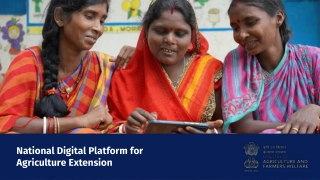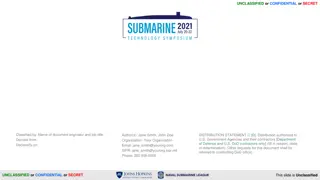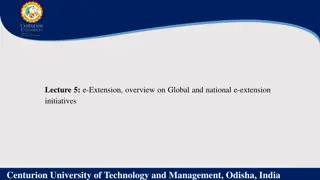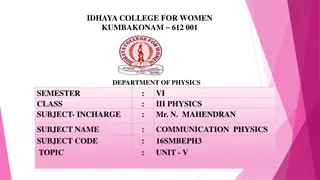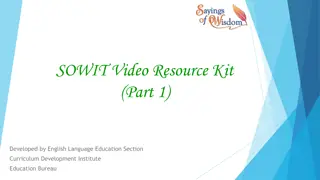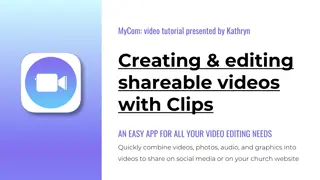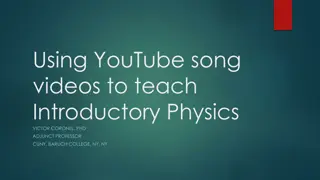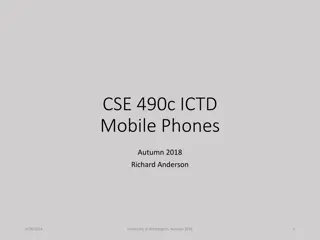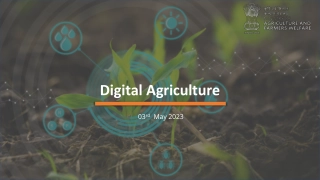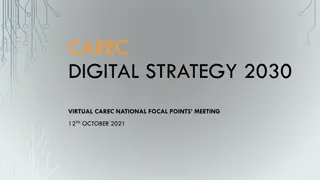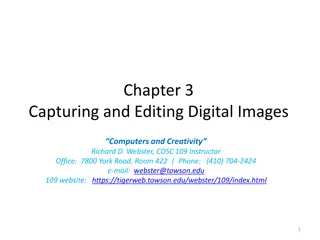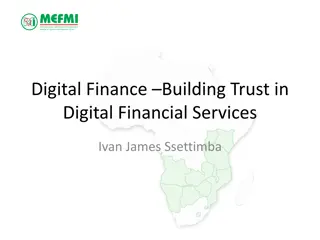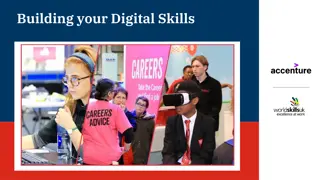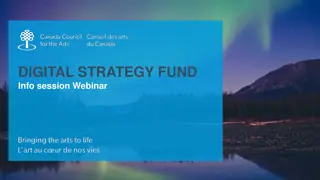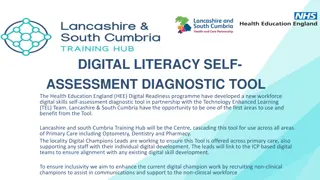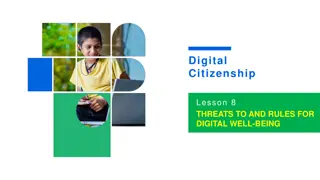Comprehensive Guide to Developing Mobile Applications and Digital Videos for Agriculture
Learn how to develop mobile applications and digital videos for agriculture to assist farmers and agricultural stakeholders. From setting clear goals to designing user-friendly interfaces and promoting your creations, this guide covers the essential steps for success in the digital agriculture realm.
Download Presentation

Please find below an Image/Link to download the presentation.
The content on the website is provided AS IS for your information and personal use only. It may not be sold, licensed, or shared on other websites without obtaining consent from the author. Download presentation by click this link. If you encounter any issues during the download, it is possible that the publisher has removed the file from their server.
E N D
Presentation Transcript
Lecture 22: Development of mobile applications, developing digital videos- story board- video recording- video editing Centurion University of Technology and Management, Odisha, India
Development of mobile applications Mobile applications for agriculture can be a great way to help farmers and other agricultural stakeholders access information and resources. Start with a clear goal in mind. What do you want your mobile application to achieve? Do you want to provide farmers with access to information about crop management, livestock production, or market prices? Do you want to connect farmers with other agricultural stakeholders? Once you know your goal, you can start to develop a plan for your mobile application. Identify your target audience. Who are you developing your mobile application for? Farmers? Agricultural professionals? Policymakers? Once you know your target audience, you can start to tailor the content and design of your mobile application to their needs. Gather the right information. What information do you need to include in your mobile application? This could include information about crop varieties, soil types, weather forecasts, market prices, and agricultural research. You can gather this information from a variety of sources, such as government websites, agricultural research institutions, and agricultural trade associations. Centurion University of Technology and Management, Odisha, India
Design a user-friendly interface. The user interface of your mobile application should be easy to use and navigate. You should use clear and concise language, simple icons, and large fonts. You should also use consistent design elements throughout your mobile application. Make sure your mobile application is secure. Your mobile application should be secure from unauthorized access. You should use encryption to protect user data. You should also use security best practices, such as password management and regular security updates. Test your mobile application thoroughly. Before you release your mobile application to the public, you should test it thoroughly. You should test the functionality of your mobile application, as well as the user interface. You should also test your mobile application on a variety of devices to ensure that it works properly. Promote your mobile application. Once you have developed and tested your mobile application, you need to promote it to your target audience. You can promote your mobile application through social media, email marketing, and agricultural publications. Centurion University of Technology and Management, Odisha, India
DEVELOPING DIGITAL VIDEOS Developing digital videos for agriculture can be a powerful way to communicate and educate farmers, provide demonstrations, showcase best practices, and promote agricultural products 1.Define Your Goals: Determine the purpose of your video. Are you aiming to educate farmers about a specific technique or technology, promote a product, or provide step-by-step instructions? Clearly defining your goals will help shape the content and direction of your video. 2.Research and Plan: Conduct thorough research on the topic of your video. Gather information, statistics, and visuals that support your message. Develop a script or outline that outlines the key points you want to cover and the flow of the video. Consider the target audience and their level of knowledge when planning the content and language used. 3.Pre-production: Gather the necessary equipment and resources for filming. This may include a high-quality camera or smartphone with good video capabilities, microphones for clear audio, lighting equipment, and any props or visuals needed. Scout locations if necessary and plan for any interviews or demonstrations that need to be included. Centurion University of Technology and Management, Odisha, India
4.Scripting and Storyboarding: Finalize your script and create a storyboard, which is a visual representation of each scene or shot in your video. The storyboard helps you plan camera angles, transitions, and visual elements to ensure a coherent and engaging video. 5.Filming: Capture your video footage according to your storyboard and script. Pay attention to lighting, sound quality, and framing to ensure a professional result. If needed, record interviews or demonstrations with experts or farmers to add credibility and authenticity to your content. 6.Editing: Transfer your video footage to a computer and use video editing software to edit and enhance your video. Trim unnecessary footage, add transitions, graphics, and captions, and adjust audio levels. Consider using music or voiceovers to enhance the overall impact of your video. 7.Visual Enhancements: Incorporate relevant visuals such as infographics, charts, or text overlays to reinforce key points or statistics. This helps make complex information more digestible and visually engaging for the audience. Centurion University of Technology and Management, Odisha, India
8.Length and Format: Keep your videos concise and focused. Aim for a length that holds viewers' attention and conveys the information effectively. In terms of format, consider the platforms where your video will be published (e.g., website, social media) and optimize the video file size and resolution accordingly. 9.Branding and Call-to-Action: Incorporate your branding elements such as logos, colors, and contact information to reinforce your identity and make it easy for viewers to connect with you. 10.Distribution and Promotion: Determine the platforms where you will publish and promote your video, such as your website, YouTube, social media channels, or industry-specific platforms. Optimize video titles, descriptions, and tags with relevant keywords to improve discoverability. 11.Evaluation and Feedback: Monitor video performance by analyzing metrics such as views, engagement, and comments. Collect feedback from viewers and stakeholders to gauge the impact of your video and identify areas for improvement in future productions. Centurion University of Technology and Management, Odisha, India


